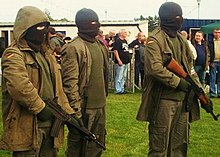Active service unit
In 1977, the IRA moved away from the larger conventional military organisational principle owing to its perceived security vulnerability.
Firstly, the old "company" structures were used to supply auxiliary members for support activities such as intelligence-gathering, acting as lookouts or moving weapons.
To improve security and operational capacity these ASUs were smaller, tight-knit cells, usually consisting of five to eight members, for carrying out armed attacks.
[7] The exception to this reorganisation was the South Armagh Brigade which retained its traditional hierarchy and battalion structure and used relatively large numbers of volunteers in its actions.
[8] Some operations, like the attack on Cloghogue checkpoint or the South Armagh sniper squads, involved as many as 20 volunteers, most of them in supporting roles.

